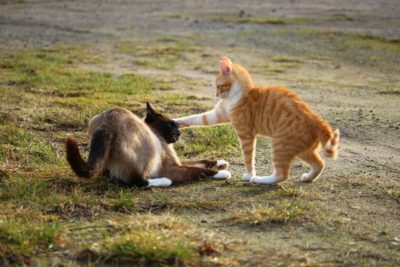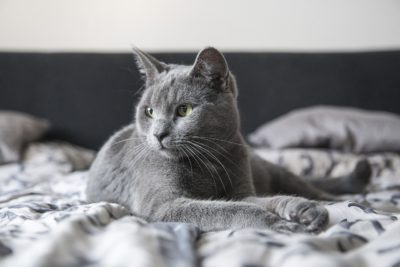
Conflict is the backbone of storytelling. Without it, a story is a lukewarm word puddle. And you don’t just need some of it, you need a lot to have a compelling tale. So what is conflict and how do we pile it into our narratives? Conflict is the struggle between opposing forces. It can be internal or external, and it’s important to have both in your stories.
The key to increasing tension as your story progresses is to layer conflict. This means adding more and more struggles for your main character(s) as you build toward the climax where conflict peaks. The best type of conflict is in direct opposition to the character’s motivation. So if your main lead desires freedom, you build in multiple methods that stop them from being free.
There are seven different types of story conflict you can utilize in your story. I’ll use the cats pictured above as an example. Our dark haired hero, Catalie Portman, has been bullied by her nemesis, Cindy Clawford, for years. Catalie sweeps the floors in Vanity Fur, the premiere feline salon where Cindy is the most popular stylist. Catalie dreams of running her own salon one day where all cats will feel beautiful, no matter what they look like.
Conflict Type 1: Battling SELF (internal)
These are the internal struggles that prevent the character from achieving their goals. It could be past memories, bad habits, self-criticism, personal expectations, or fear and doubt. When I’m planning and revising novels, I always check each chapter to make sure there’s this internal conflict along with external conflict. In our feline example, Catalie is full of self-doubt from her overly critical mother who starred on the TV soap All My Kittens. She also had an unfortunate attempt at styling that turned out to be a disaster that still haunts her today.
Conflict Type 2: Battling OTHERS (external)
This is when the main character is confronted by the other characters in the story. It includes physical assaults as well as emotional attacks from jealous, competitive or critical characters. It could also come in the form of an argument with someone close to the lead. Catalie is attacked emotionally on a daily basis by Cindy Clawford, and she even gets whacked on the head when she accidentally knocks over Cindy’s hair dye. On top of that, the shop owner, a sinister tortoise named Voldetorte, blackmails her into spying on a rival salon. If she succeeds, she will have her dream of her own salon. If she fails, she will be out of the business forever.
Conflict Type 3: Battling SOCIETY (external)
Societies have a structure and history that can create conflict for a character. This may be who has power, a history of how certain groups have been treated, a rule system, or even expectations of how certain genders or kinds are supposed to behave. Catalie is a short-haired feline and is treated as less valued than the long-haired aristocats. She can’t afford the extensions Cindy uses to fit in, and there is no way she would be respected enough to have her own salon.
Conflict Type 4: Battling NATURE (external)
Nature has an immense variety of challenges to present: intense weather, rabid animals, diseases, pollution, and even time itself. Be sure whatever conflict you choose makes sense in the setting you’ve made or selected. It’s easy to get carried away and try to force something in that doesn’t fit. Since my story world revolves around cats, I would likely involve the greatest enemy: water. Heavy rains and possibly even a flood would be in store for our heroine.
Conflict Type 5: Battling MACHINE (external)
This will vary greatly depending on your setting. Some story worlds have more technology than others. A modern setting might have problems with computer viruses, AI, cell phones, cars, or malfunctioning equipment. If your story takes place during the Oregon Trail days, your character might have problems with wagon wheels, butter churns, yolks for the oxen and so forth. Catalie will have an incident with the chairs at the rival salon that will give away her position. Her camera will also malfunction at a key point.
Conflict Type 6: Battling SUPERNATURAL (external)
The supernatural may or may not have a place in your story. It can be quite fun when it does! This includes God or other deities, paranormal creatures, evil forces, ghosts, and mythical beings. Catalie has a fairy dogmother who in her attempts to help, ends up making things worse for her. The dream of her own salon is getting further and further away.
Conflict Type 7: Battling FATE (external)
The character may also have conflict with fate, which involves premonitions, predetermined paths, and genetic destinies. Before she was born, Catalie’s mother was told by a mystic that her child would bring shame to her name. She’s never let Catalie forget it. But at the climax of the story, we find out her long lost brother believed to be dead is still alive. Who will be the true shame? Find out in book two!
As you can see, there are many ways to add more conflict to your story and layer the issues as the narrative progresses. They key to having organic conflict is to put it in direct opposition to what the character wants as well as draw from the setting of the story. I did everything I could to stop Catalie from getting that salon she’s always wanted, but something tells me we’ll be seeing Pampurred Spa soon.


Jerold H. Tabbott
I was sincerely touched by Catalie’s story, and I hope everything works out for her. The obstacles you’ve placed in her path are unfurgivingly catastrophic.
I’ll stop there. Nice article. Thanks.
Arielle Haughee
Ha! Love it. Glad you enjoyed!
Paul
Another useful article. Thanks!
Arielle Haughee
Thank you, Paul!
Amarilys Rassler
Thank you. Very informative, helpful.
Arielle Haughee
Thank you, Amarilys. So glad you found it helpful.
Jenny Ferns
Funny! That’s a great way to teach.
Arielle Haughee
Thank you! Strangely, I am a dog person who likes to write about cats.